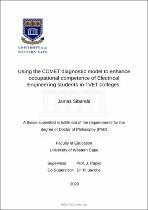| dc.description.abstract | It is common cause that rapid digitisation and automation of industries has resulted in new challenges for current and future labour markets in which automated systems are constantly raising the complexity of tasks and demanding higher skills for entry-level positions. TVET colleges are seen as key institutions for training that is responsive to industry and skills needs, but there has been ongoing concern about the quality of TVET graduates, and whether the training offered at TVET colleges produces graduates with cutting-edge knowledge and skills. It has been argued that one of the ways to improve the quality and occupational competence of TVET graduates is a focus on teaching and learning, hence this research that shines a light on current teaching models and investigates what might improve poor throughput rates. The COMET (Competence Measurement in Electrical Technology), three-dimensional Diagnostic Model showed potential in earlier studies to both measure and develop occupational competence in TVET, but to date there has been no study to specifically explore the didactic application of the model, which is the knowledge gap addressed in this thesis. A longitudinal study was undertaken in the TVET Electrical Engineering domain to investigate how the COMET diagnostic model might be applied didactically in the quest to enhance the occupational competence of students at TVET colleges in South Africa. A mixed-methods sequential explanatory research design was adopted in which quantitative and qualitative data were collected from a purposive sample representative of five TVET colleges across four South African provinces. Open-ended test tasks inspired by authentic industry activities were designed to develop and test students’ holistic problem-solving capabilities and their occupational competence. A large Cohen effect size value (d = 0.8) is reported between the professional occupational competence profiles of participating TVET students in the Baseline and Main Tests, which offer compelling evidence of the COMET diagnostic model’s didactic enhancement of TVET Electrical Engineering student’s occupational competence development in the current investigation. These findings highlight the COMET model’s didactic potential to assess and develop occupational competence in TVET Electrical Engineering and underscore the COMET model as a valuable didactic tool that South African TVET colleges can implement, in order to bridge the existing divide between competence development at TVET institutions and industry-related occupational competence required for entry level positions. The findings of this research provide strategic guidance for assisting TVET students to achieve the holistic problem-solving competence that would be valuable to modern societies and work. Moreover, this study has the potential to inform other TVET programmes and to become a necessary didactic tool for college educators. | en_US |

